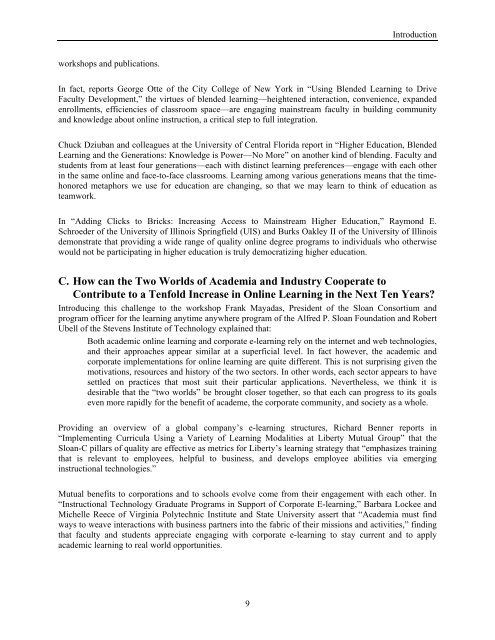Elements of Quality Online Education cation
Elements of Quality Online Education cation
Elements of Quality Online Education cation
You also want an ePaper? Increase the reach of your titles
YUMPU automatically turns print PDFs into web optimized ePapers that Google loves.
Introductionworkshops and publi<strong>cation</strong>s.In fact, reports George Otte <strong>of</strong> the City College <strong>of</strong> New York in “Using Blended Learning to DriveFaculty Development,” the virtues <strong>of</strong> blended learning—heightened interaction, convenience, expandedenrollments, efficiencies <strong>of</strong> classroom space—are engaging mainstream faculty in building communityand knowledge about online instruction, a critical step to full integration.Chuck Dziuban and colleagues at the University <strong>of</strong> Central Florida report in “Higher <strong>Edu<strong>cation</strong></strong>, BlendedLearning and the Generations: Knowledge is Power—No More” on another kind <strong>of</strong> blending. Faculty andstudents from at least four generations—each with distinct learning preferences—engage with each otherin the same online and face-to-face classrooms. Learning among various generations means that the timehonoredmetaphors we use for edu<strong>cation</strong> are changing, so that we may learn to think <strong>of</strong> edu<strong>cation</strong> asteamwork.In “Adding Clicks to Bricks: Increasing Access to Mainstream Higher <strong>Edu<strong>cation</strong></strong>,” Raymond E.Schroeder <strong>of</strong> the University <strong>of</strong> Illinois Springfield (UIS) and Burks Oakley II <strong>of</strong> the University <strong>of</strong> Illinoisdemonstrate that providing a wide range <strong>of</strong> quality online degree programs to individuals who otherwisewould not be participating in higher edu<strong>cation</strong> is truly democratizing higher edu<strong>cation</strong>.C. How can the Two Worlds <strong>of</strong> Academia and Industry Cooperate toContribute to a Tenfold Increase in <strong>Online</strong> Learning in the Next Ten Years?Introducing this challenge to the workshop Frank Mayadas, President <strong>of</strong> the Sloan Consortium andprogram <strong>of</strong>ficer for the learning anytime anywhere program <strong>of</strong> the Alfred P. Sloan Foundation and RobertUbell <strong>of</strong> the Stevens Institute <strong>of</strong> Technology explained that:Both academic online learning and corporate e-learning rely on the internet and web technologies,and their approaches appear similar at a superficial level. In fact however, the academic andcorporate implementations for online learning are quite different. This is not surprising given themotivations, resources and history <strong>of</strong> the two sectors. In other words, each sector appears to havesettled on practices that most suit their particular appli<strong>cation</strong>s. Nevertheless, we think it isdesirable that the “two worlds” be brought closer together, so that each can progress to its goalseven more rapidly for the benefit <strong>of</strong> academe, the corporate community, and society as a whole.Providing an overview <strong>of</strong> a global company’s e-learning structures, Richard Benner reports in“Implementing Curricula Using a Variety <strong>of</strong> Learning Modalities at Liberty Mutual Group” that theSloan-C pillars <strong>of</strong> quality are effective as metrics for Liberty’s learning strategy that “emphasizes trainingthat is relevant to employees, helpful to business, and develops employee abilities via emerginginstructional technologies.”Mutual benefits to corporations and to schools evolve come from their engagement with each other. In“Instructional Technology Graduate Programs in Support <strong>of</strong> Corporate E-learning,” Barbara Lockee andMichelle Reece <strong>of</strong> Virginia Polytechnic Institute and State University assert that “Academia must findways to weave interactions with business partners into the fabric <strong>of</strong> their missions and activities,” findingthat faculty and students appreciate engaging with corporate e-learning to stay current and to applyacademic learning to real world opportunities.9
















